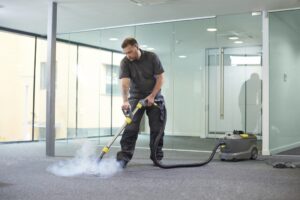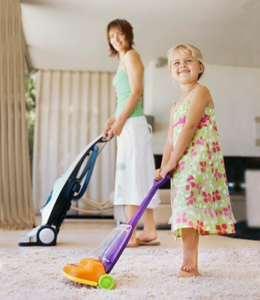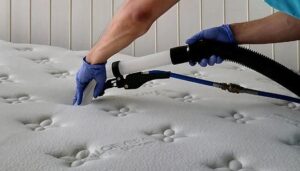Carpet Cleaning Springdale AR use machines that mix water, detergent, and suction to remove dirt from your carpet. They also have extra tools to reach tough spots, such as stairs.
Keeping your carpets clean can improve multiple areas of your life. It can help prevent allergies, improve your home’s air quality, and even reduce stress.

Your carpet is a trap for soil, dust, and debris that settles inside the fibers. Over time, these pollutants are released into the air by walking over the contaminated carpet. Regular cleaning from professional carpet cleaners can reduce the airborne pollutants in your home, improving your family’s health.
Dirty carpets also retain a variety of harmful microorganisms like mildew and mold. These organisms grow quickly in damp conditions and can cause respiratory problems for people with weak immune systems. These contaminants are especially dangerous to children, as their developing immune system makes them more susceptible to infection. Regular carpet cleaning can help keep your children healthy and avoid respiratory complications caused by airborne pollutants.
The professional carpet cleaning process uses steam from water to force dirt and other accumulated substances onto the surface for extraction. The fresher carpets eliminate odors that can make your home smell dirty and unpleasant. It also removes pet hair and other stains, leaving your house with a clean scent.
Regularly using professional carpet cleaners will ensure your rugs and carpets are free from dust mites. These tiny organisms feed on accumulated dust and other particles in the carpet, releasing waste material that can cause allergies when inhaled by people with sensitive lungs. Regular carpet cleaning can prevent dust mites from infesting your household and will significantly improve the quality of your life by minimizing allergies and asthma attacks.
Dirty and stained carpets are also breeding grounds for pests and parasites like cockroaches, termites, and ants. If left unattended, these organisms can spread to other parts of the house and pose a serious health risk for your loved ones. Professional carpet cleaners will clear away these pests and their nests to ensure your family is safe from the risk of contracting a disease.
Your family’s health is important, and you want to enjoy your time at home without worrying about their well-being. A clean and sanitary environment will greatly improve everyone’s mood and help them feel more comfortable in the home. Professional carpet cleaners will ensure that your upholstered surfaces are always free from bacteria, viruses, and other contaminants that can pose a serious health risk to your family.
Carpets act as giant air filters, trapping many floating particles. This includes dust, pollen, pet dander, bacteria, and mold spores, which can be harmful when inhaled. Regular vacuuming and professional carpet cleaning remove these trapped contaminants, improving indoor air quality and reducing allergy symptoms.
One of the biggest factors contributing to poor indoor air quality is humidity, which can cause the surfaces in your home to crack and warp over time. This can lead to various problems, including mildew and mold growth, increased dust mite populations, and an uncomfortable environment for you and your family. The best way to prevent these issues is to keep your home’s humidity in the proper range. This is achieved by keeping your floors and walls well-ventilated and regularly vacuuming and cleaning your carpets.
Dirty carpets can also harbor moisture, which can lead to the formation of mold and mildew. Professional carpet cleaners use equipment that extracts excess water and keeps your carpets dry, preventing these unpleasant conditions.
Moreover, carpets that are properly cleaned and maintained tend to last longer than those that are not. This is because dirt and grime that become embedded in the carpet’s fibers have a harder time scratching through the carpet’s surface. This means it is less likely to wear away at the fibers, making them last longer and providing a better return on your investment.
Everything that touches your carpet has the potential to soil it, from visible stains to substances such as pet dander, mold spores, and dust particles that are invisible to the naked eye. These substances can fall on your carpet from various sources, including your clothing, and foot traffic grinds them deep into the fibers, leaving behind a clean carpet full of air pollutants. Even more obvious issues, such as food and drink spillage, can leave spots on your carpet that become a source of bacteria, which only exacerbates the problem.
The dirty appearance of your home’s carpets can have a negative psychological impact on you and your family. Psychologists have found that a clean environment helps you to feel more relaxed and at ease. It also gives you a sense of control and achievement. This is why keeping your carpets looking their best at all times is important.
Ensuring that your carpets remain tidy is even more vital if you have children. A dirty carpet can make your entire house look unkempt and unclean. This can lead to them feeling overwhelmed and anxious. By hiring professional carpet cleaners to clean for you, you can remove this source of stress from your life and enjoy a more relaxing atmosphere.
Professional carpet cleaners have the expertise and equipment to tackle dirt, dust mites, allergens, and other harmful pollutants that accumulate in your carpets. Their hot water treatment eliminates these pollutants, leaving your home with fresher air that’s healthier for you and your family.
Dirty carpets act as a breeding ground for bacteria and viruses. The food particles, pet hair, and human hair that get trapped in them nourish these microorganisms. They then circulate in the air along with dust particles and can cause various health conditions, such as skin and lung allergies, rhinitis, and gastric discomfort.
When you hire professional carpet cleaners to clean your home, they’ll have a larger tank capacity than you would find on a standard vacuum cleaner. This means that they can clean your carpets more thoroughly in less time. In addition, they’ll have tools that can help reduce the amount of moisture in your carpets. This will prevent the growth of mold and mildew, which can negatively affect indoor air quality.
The main benefit of using a carpet cleaner is that it makes your carpets look their best and smell fresher. The machine uses heat, pressure, and a special brush to lift dirt and debris from the surface of your carpets. When your carpets are clean, they’ll be softer and more comfortable to walk on. They’ll also look brighter and more inviting.
Few elements of your home will last forever, but with proper care, you can extend the lifespan of your carpets and keep them looking fresh and beautiful for years to come. Properly maintained carpets also provide a soft and comfortable living environment.
Regularly vacuuming your carpet helps to keep the dirt level down and prolongs its life. Aiming to do this at least once a week would be best, but high-traffic areas may need more frequent attention. Vacuuming regularly helps to prevent the buildup of dust, dirt, and other contaminants that can cause your carpets to lose color or texture over time.
Professional carpet cleaners help to restore your carpet’s appearance. They use hot steam to sanitize and disinfect your carpets, removing embedded dirt and grime. They also offer pre-treat stain removers that can effectively break up and dissolve stubborn stains and odors.
When caring for your carpets, it is important to understand that not all cleaning products are equal. Using a CRI (Carpet and Rug Institute) Certified Seal of Approval carpet cleaning product is important, as these have been laboratory tested to ensure they are safe and effective for your carpets. Always pretest any carpet cleaner on an out-of-the-way area or a scrap piece of your carpet before using it. Always follow the product’s directions for application and use.
A good rule of thumb is to apply the carpet cleaner to a white cloth and work it into the stain rather than scrubbing it. Once the spot has been removed, rinse and blot the area to dry it.
Cleaning carpets regularly can extend their lifespan and maintain a fresh and healthy look throughout your home. To preserve your carpets further, you should avoid placing furniture in high-traffic areas of your house and regularly rearrange your furniture to distribute weight evenly across your carpets.
Encouraging your household and guests to remove their shoes indoors upon entering the house is also helpful. This will prevent many dirt particles from tracking on your carpets and reduce the need for regular professional cleanings.


